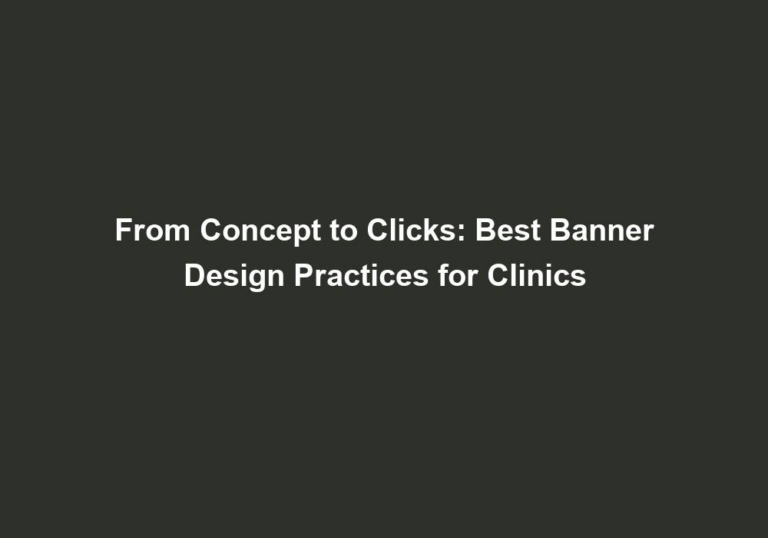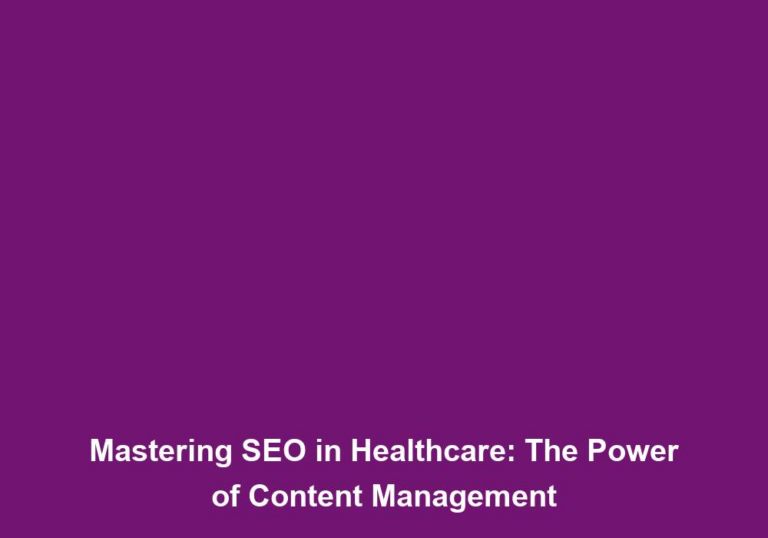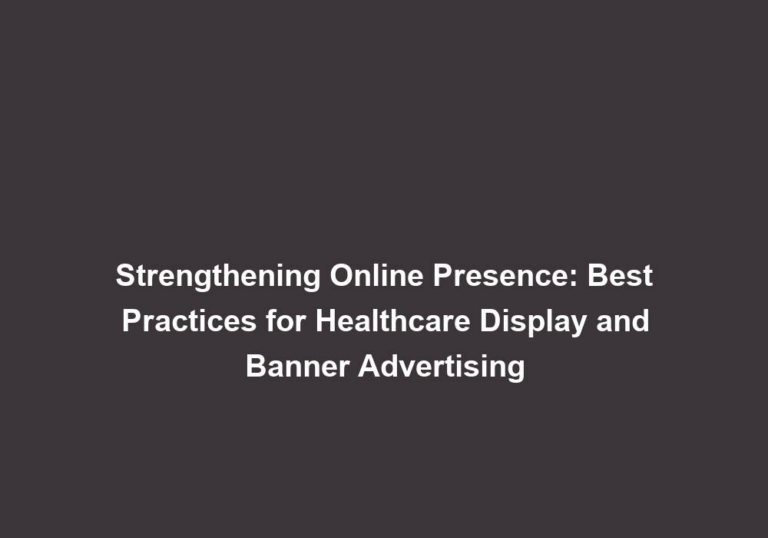Re-Engage Potential Patients: Mastering Remarketing Tactics for Healthcare Ads
In today’s digital age, engaging potential patients and driving conversions is crucial for the success of any healthcare organization. With the abundance of online platforms, remarketing tactics have become indispensable tools for reaching out to users who have shown an interest in your services but haven’t taken the desired action. In this article, we will explore the power of remarketing and provide you with valuable insights and strategies to master this technique for your healthcare ads.
What is Remarketing?
Remarketing, also known as retargeting, is a digital advertising strategy that allows you to reconnect with users who have previously visited your website or interacted with your brand in some way. By placing a cookie or pixel code on their browser, you can target these users with tailored ads across various online platforms they visit.
Remarketing works by tracking the behavior of users on your website and then displaying relevant ads to them as they browse other websites or social media platforms. This strategy is particularly effective because it allows you to stay in front of potential patients who have already shown an interest in your services, increasing the likelihood of conversion.
The Benefits of Remarketing for Healthcare Ads
Implementing remarketing tactics in your healthcare advertising campaigns offers several significant advantages:
- Increased Brand Awareness: Remarketing helps reinforce your brand in the minds of potential patients. By consistently displaying targeted ads, you ensure that your organization remains top-of-mind when they require healthcare services.
Remarketing allows you to maintain a strong presence in the online space, making your brand more recognizable and memorable. By repeatedly exposing potential patients to your ads, you increase the chances of them choosing your healthcare organization when they need medical services.
- Precise Targeting: Remarketing enables you to focus your advertising efforts on users who have already shown interest in your services. This targeting allows you to provide more relevant information and offers, increasing the chances of conversion.
By segmenting your audience based on their behavior and interests, you can create personalized ads that resonate with specific user groups. For example, you can target users who have visited specific services pages or signed up for newsletters. This precise targeting ensures that your ads are seen by individuals who are more likely to be interested in your healthcare services, increasing the effectiveness of your campaigns.
- Higher Conversion Rates: By re-engaging potential patients who have already expressed interest in your services, remarketing significantly improves conversion rates. It serves as a reminder or gentle nudge for users to take the desired action, such as booking an appointment or subscribing to a newsletter.
Remarketing campaigns act as a reminder to potential patients who may have been interested in your services but were not ready to take action during their initial visit. By repeatedly showing them relevant ads, you increase the chances of them converting and completing the desired action. This can lead to a higher conversion rate and ultimately more patients for your healthcare organization.
- Cost-Effective Advertising: Compared to traditional advertising methods, remarketing is cost-effective. You can optimize your campaigns by allocating your budget towards targeting a specific audience segment, ensuring that your ads are seen by users who are most likely to convert.
Remarketing allows you to focus your advertising budget on individuals who have already shown an interest in your services, increasing the efficiency of your campaigns. By targeting specific audience segments, you can allocate your resources more effectively and avoid wasting money on users who are unlikely to convert. This cost-effective approach can help you maximize the return on investment (ROI) of your advertising efforts.
Effective Remarketing Strategies for Healthcare Ads
To make the most of your remarketing campaigns, here are some effective strategies to consider:
1. Segment Your Audience
Divide your audience into different segments based on their behavior and interests. This segmentation allows you to create highly personalized ads that resonate with specific user groups. For example, you can create segments for users who visited specific services pages, signed up for newsletters, or abandoned the appointment booking process.
Segmenting your audience allows you to tailor your ads to the specific needs and interests of different user groups. By understanding the behavior and preferences of each segment, you can create more targeted and relevant ads that are more likely to capture the attention of potential patients. This can lead to higher engagement and conversion rates.
2. Tailor Ad Content
Create compelling ad content that addresses the needs and pain points of each audience segment. Highlight the unique benefits your healthcare organization offers and provide clear calls-to-action to encourage users to take the desired action. Personalize the message based on the user’s previous interactions to make it more engaging and relevant.
When creating ad content for your remarketing campaigns, it is important to consider the specific interests and needs of each audience segment. By addressing their pain points and highlighting the benefits of your healthcare services, you can create a more compelling message that resonates with potential patients. Additionally, incorporating personalized elements based on their previous interactions with your brand can further enhance the effectiveness of your ads.
3. Utilize Dynamic Remarketing
Dynamic remarketing takes personalization to the next level by displaying ads that showcase the exact products or services users previously viewed on your website. In the healthcare industry, this can include promoting specific treatments, procedures, or healthcare packages that align with the user’s interests.
Dynamic remarketing allows you to show potential patients the specific services or treatments they have shown interest in. By displaying ads that align with their previous interactions, you can increase the relevance and effectiveness of your campaigns. This personalized approach can significantly improve conversion rates and drive more patients to choose your healthcare organization.
4. Optimize Landing Pages
Ensure that your landing pages are optimized for conversions. When users click on your remarketing ads, they should be directed to a relevant, user-friendly landing page that provides a seamless experience. Make sure the landing page clearly communicates the value and benefits of your services and includes a clear call-to-action.
A well-optimized landing page is essential for converting potential patients who click on your remarketing ads. The landing page should align with the ad content and provide the necessary information to encourage users to take the desired action. It should be user-friendly, visually appealing, and clearly communicate the unique value and benefits of your healthcare services. Including a clear and compelling call-to-action can further enhance the conversion rate of your remarketing campaigns.
5. Frequency Capping
Avoid bombarding users with excessive remarketing ads. Set frequency caps to limit the number of times your ads appear to the same user within a specific timeframe. This prevents ad fatigue and annoyance, ensuring that your ads remain effective and well-received.
While remarketing can be a powerful strategy, it is important to strike a balance and avoid overwhelming potential patients with excessive ads. Setting frequency caps allows you to control the number of times your ads are shown to the same user, preventing ad fatigue and annoyance. By maintaining a reasonable frequency, you can ensure that your ads remain effective and well-received, increasing the chances of conversion.
6. A/B Testing
Continuously test different ad variations, landing pages, and calls-to-action to identify the most effective combinations. A/B testing allows you to make data-driven decisions and optimize your remarketing campaigns for better performance.
A/B testing is a valuable technique that can help you optimize your remarketing campaigns. By testing different ad variations, landing pages, and calls-to-action, you can gather data and insights to identify the most effective combinations. This data-driven approach allows you to make informed decisions and continually improve the performance of your remarketing campaigns, ultimately leading to better results and higher conversion rates.
7. Monitor and Analyze Results
Regularly monitor and analyze the performance of your remarketing campaigns. Identify key metrics such as click-through rates, conversion rates, and cost per acquisition to evaluate the success of your ads. Use these insights to refine your strategies and improve the overall effectiveness of your healthcare remarketing campaigns.
Monitoring and analyzing the results of your remarketing campaigns is essential for understanding their effectiveness and making informed decisions. By tracking key metrics such as click-through rates, conversion rates, and cost per acquisition, you can evaluate the performance of your ads and identify areas for improvement. This data-driven approach allows you to refine your strategies, optimize your campaigns, and continuously improve the overall effectiveness of your healthcare remarketing efforts.
Conclusion
Mastering remarketing tactics for healthcare ads is a powerful way to re-engage potential patients and drive conversions. By implementing effective strategies such as audience segmentation, tailored ad content, and dynamic remarketing, you can create personalized and compelling campaigns that resonate with users’ needs. Remember to optimize your landing pages, set frequency caps, conduct A/B testing, and analyze campaign results regularly to continually improve your remarketing efforts. By harnessing the power of remarketing, you can stay ahead in the competitive healthcare landscape and maximize the impact of your digital advertising campaigns.







